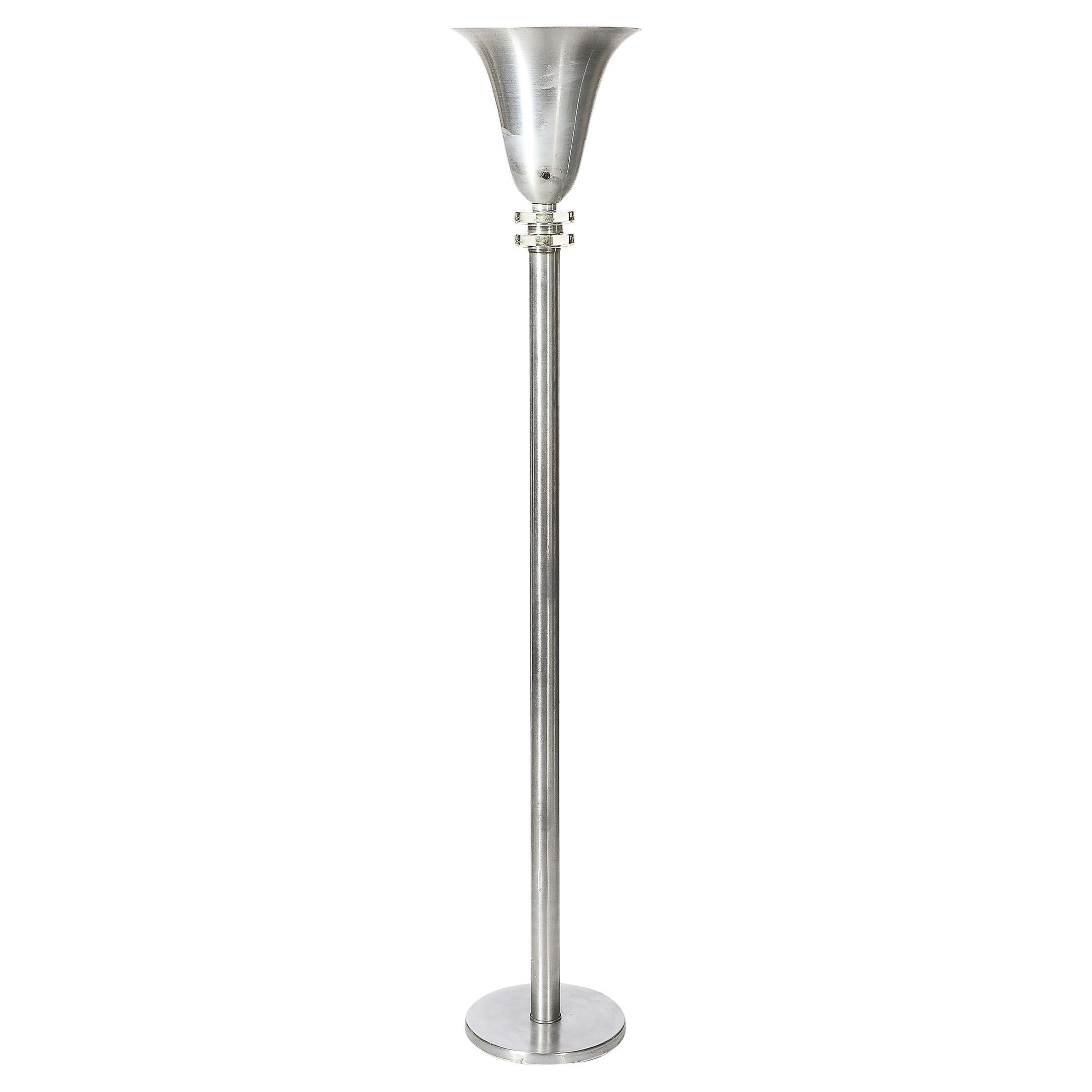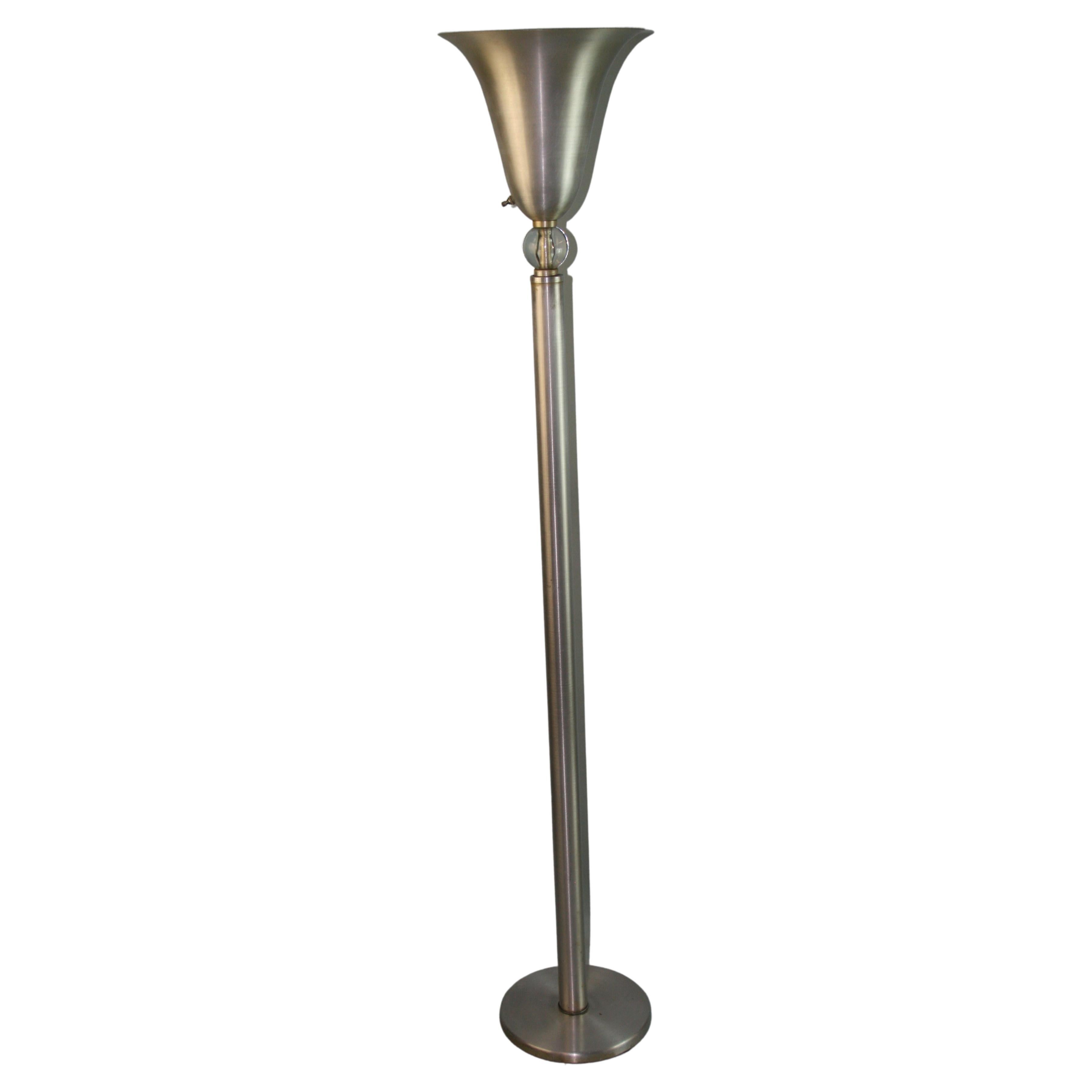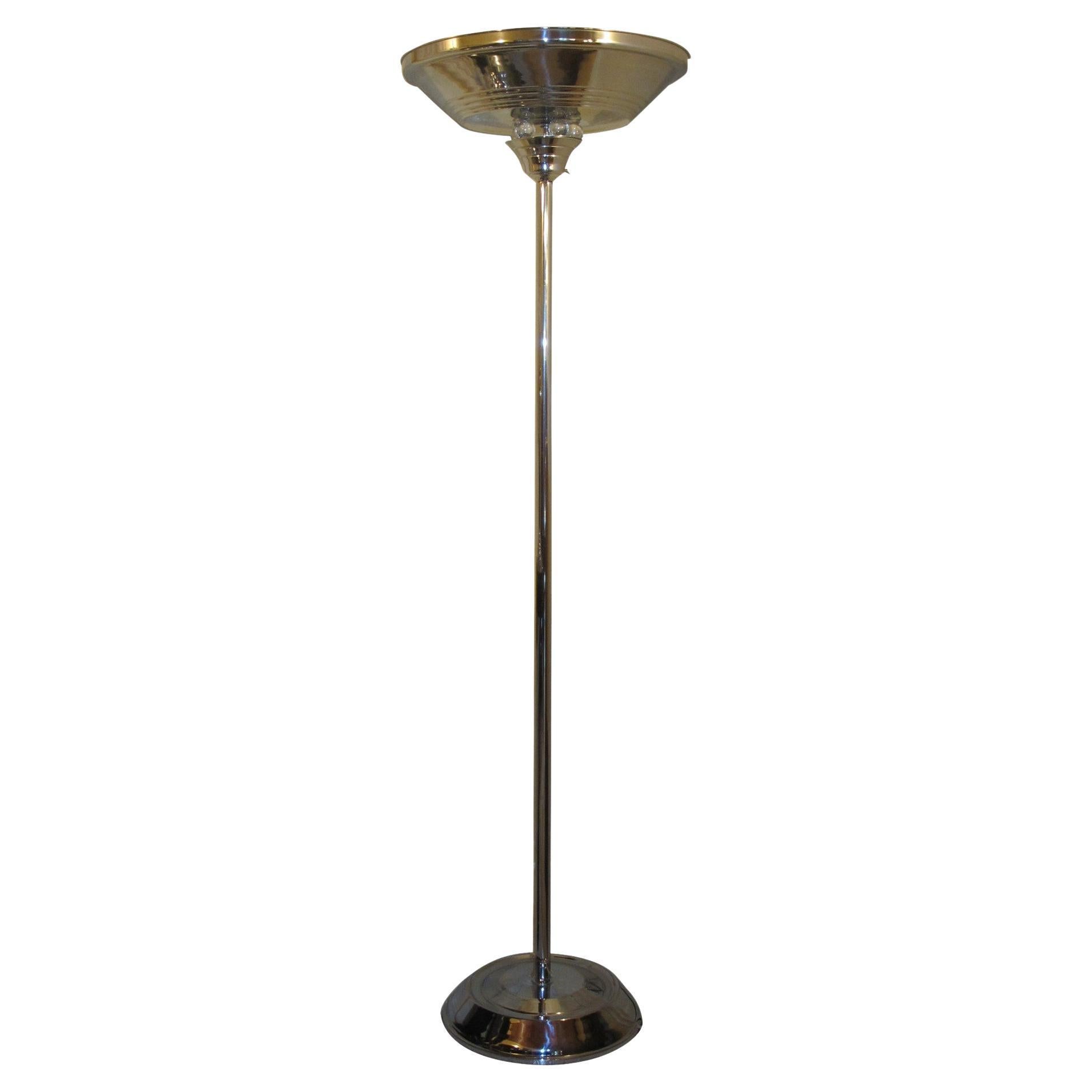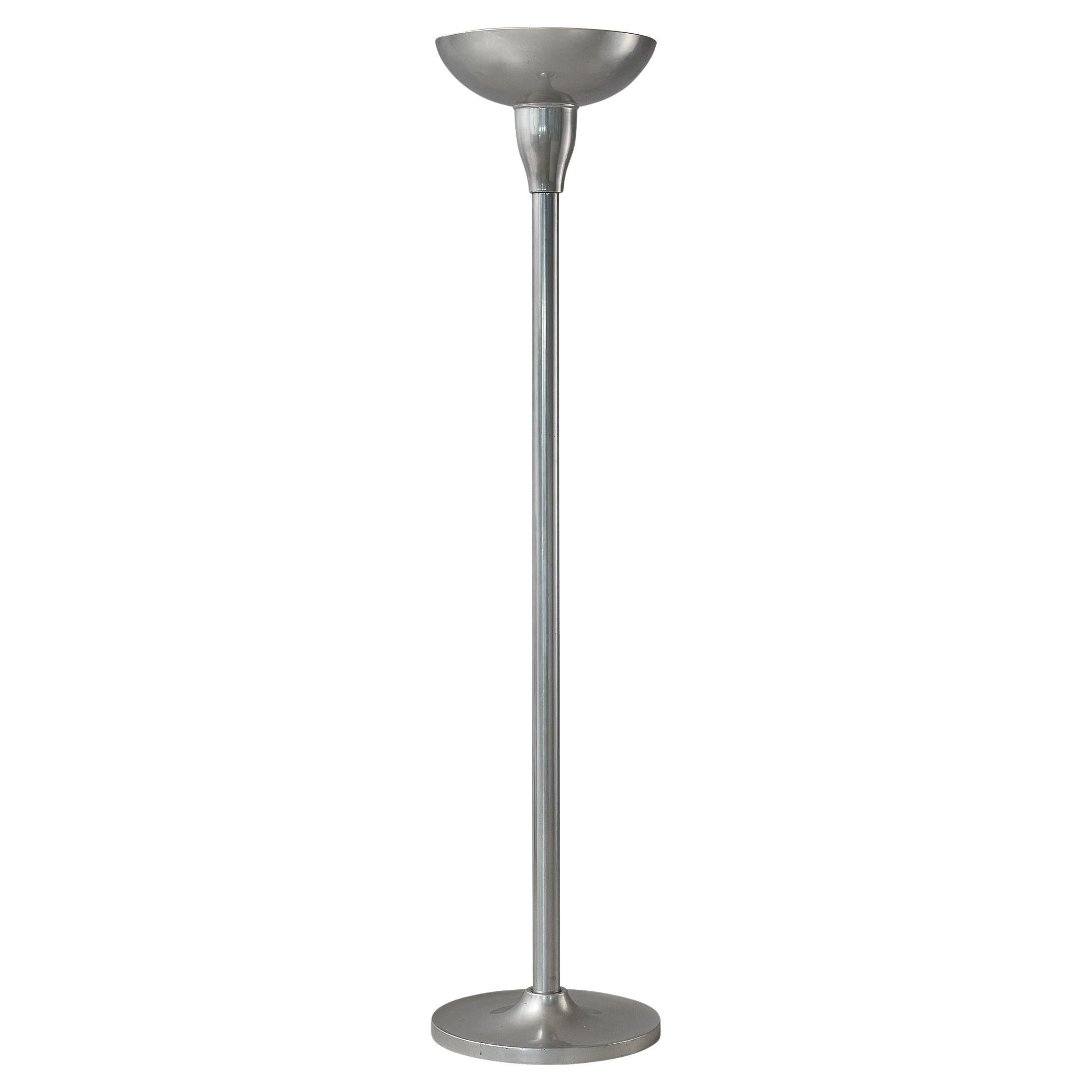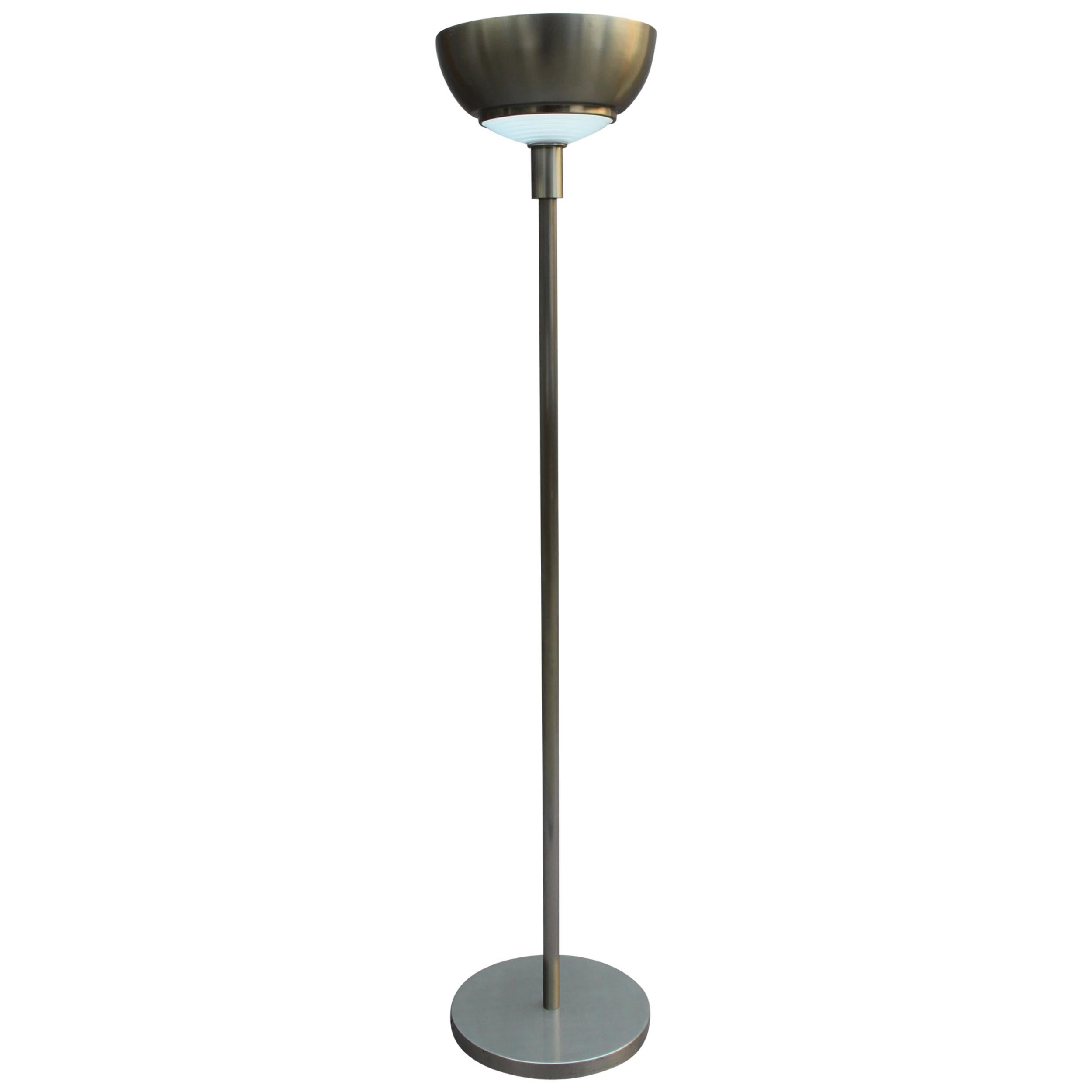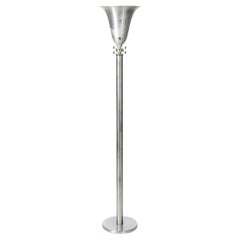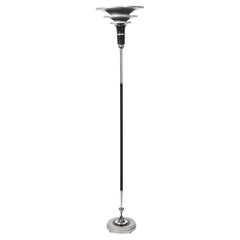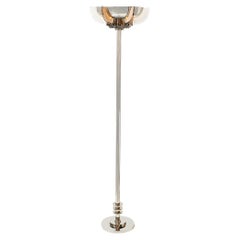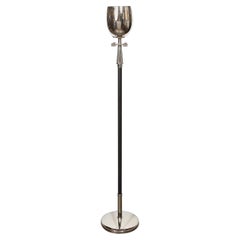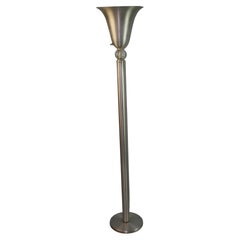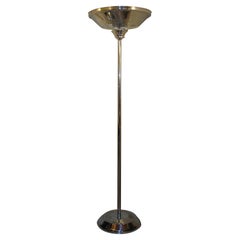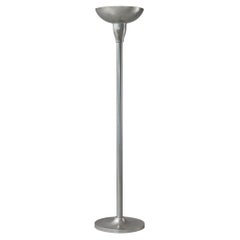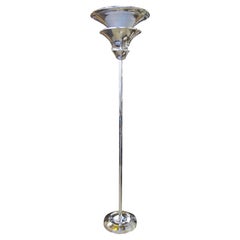Items Similar to Art Deco "Palma" Torchiere in Glass & Brushed Aluminum by Walter Von Nessen
Want more images or videos?
Request additional images or videos from the seller
1 of 11
Art Deco "Palma" Torchiere in Glass & Brushed Aluminum by Walter Von Nessen
$5,975
£4,536.12
€5,188.35
CA$8,347.94
A$9,284.73
CHF 4,848.20
MX$112,985.33
NOK 61,918.90
SEK 58,069.01
DKK 38,722.66
Shipping
Retrieving quote...The 1stDibs Promise:
Authenticity Guarantee,
Money-Back Guarantee,
24-Hour Cancellation
About the Item
This stunning Art Deco torchiere was realized by the legendary Walter Von Nessen in the United States circa 1940. Executed in polished aluminum (the material for which Von Nessen is most renowned) the torchiere offers a volumetric circular base from which a cylindrical body ascends culminating in a cupped concave aluminum shade with a frosted glass insert gently diffusing the light from within throughout any interior setting. The neck is sheathed in palma shades- an ode to High Style Art Deco- with arched forms and channeled incised surfaces, crowned with a glass disc secured by orbital aluminum rivets. With its clean modernist lines and forward looking aesthetic, this piece is as versatile as it is aesthetically compelling, blending with any style of interior from classic Deco to contemporary. It has been newly rewired to American standards and is in excellent vintage condition.
Von Nessen was born in Germany, where he studied under Bruno Paul at Berlin’s Kunstgewerbeschule. After World War I, he worked for the architect Peter Behrens in Berlin. He left in 1919 for Stockholm, where he designed furniture until emigrating with his wife, Margaretta, to the United States in 1923. In 1927, the couple opened Nessen Studios in Manhattan, designing and selling avante garde, modern architectural lighting.
Along with visionaries of the period like Gilbert Rohde and Donald Deskey, von Nessen created a style that was emblematic of the Machine Age. He produced lamps and home accessories from spun aluminum, with smooth surfaces that evoked the polished gleam of streamlined automobiles and airplanes. Von Nessen’s work is represented in the collections of the Museum of Modern Art and the Cooper Hewitt Smithsonian National Design Museum, among other institutions.
American, circa 1940
Dimensions:
height: 68.5" x diameter: 19"
- Dimensions:Height: 68.5 in (173.99 cm)Diameter: 19 in (48.26 cm)
- Style:Art Deco (Of the Period)
- Materials and Techniques:
- Place of Origin:
- Period:
- Date of Manufacture:circa 1940
- Condition:Rewired.
- Seller Location:New York, NY
- Reference Number:1stDibs: LU793431348422
About the Seller
5.0
Platinum Seller
Premium sellers with a 4.7+ rating and 24-hour response times
Established in 2004
1stDibs seller since 2004
2,237 sales on 1stDibs
Typical response time: <1 hour
- ShippingRetrieving quote...Shipping from: New York, NY
- Return Policy
Authenticity Guarantee
In the unlikely event there’s an issue with an item’s authenticity, contact us within 1 year for a full refund. DetailsMoney-Back Guarantee
If your item is not as described, is damaged in transit, or does not arrive, contact us within 7 days for a full refund. Details24-Hour Cancellation
You have a 24-hour grace period in which to reconsider your purchase, with no questions asked.Vetted Professional Sellers
Our world-class sellers must adhere to strict standards for service and quality, maintaining the integrity of our listings.Price-Match Guarantee
If you find that a seller listed the same item for a lower price elsewhere, we’ll match it.Trusted Global Delivery
Our best-in-class carrier network provides specialized shipping options worldwide, including custom delivery.More From This Seller
View AllArt Deco Machine Age Torchiere in Brushed Aluminum & Glass signed Russel Wright
By Russel Wright
Located in New York, NY
This Art Deco Machine Age torchiere, signed by the renowned American industrial designer Russel Wright, is a stunning piece from circa 1940. The torchiere features a sophisticated bl...
Category
Vintage 1940s American Art Deco Floor Lamps
Materials
Aluminum
Art Deco Machine Age Torchiere in Brushed Aluminum & Chrome W/ Black Enamel
Located in New York, NY
This exquisite Art Deco machine age torchiere, dating back to circa 1935, exemplifies the sophisticated design and craftsmanship of the era. The torchiere features a sleek brushed al...
Category
Vintage 1930s American Art Deco Floor Lamps
Materials
Aluminum, Enamel, Chrome
Art Deco Machine Age Skyscraper Style Nickel Torchiere w/ Rose & Clear Glass
Located in New York, NY
This exquisite Art Deco torchiere, created in France circa 1930, exemplifies the Machine Age aesthetic with its striking Skyscraper style design. The torchiere features a gleaming po...
Category
Vintage 1930s French Art Deco Floor Lamps
Materials
Nickel
Midcentury Polished Nickel & Black Enamel Floor Lamp, Manner of Tommi Parzinger
By Tommi Parzinger
Located in New York, NY
This refined Mid-Century Modern floor lamp was realized in the United States, circa 1950. Designed in the manner of Tommi Parzinger, the floor lamp features a circular polished nicke...
Category
Vintage 1950s American Mid-Century Modern Floor Lamps
Materials
Enamel, Nickel
Mid-Century Modern Polished Nickel Urn Form Torchère by Tommi Parzinger
By Tommi Parzinger
Located in New York, NY
This elegant Mid-Century Modern torchère was realized by the fabled 20th century design luminary Tommi Parzinger in the United States, circa 1950. It ...
Category
Vintage 1950s American Mid-Century Modern Floor Lamps
Materials
Nickel
Mid-Century Modern Chrome and Frosted Glass Staggered Uplight/ Table Lamp
Located in New York, NY
This stunning and graphic Mid-Century Modern uplight/ table lamp was realized in the United States, circa 1970. It features four cylindrical bodies risi...
Category
Vintage 1970s American Mid-Century Modern Table Lamps
Materials
Chrome
You May Also Like
Art Deco Machine Age Brushed Aluminum and Glass Torchiere by Russel Wright
Located in Douglas Manor, NY
1280 Art Deco Machine Age brushed aluminum circular base from which a aluminum body ascends to a billowing urn form shade seperated by translucent spherical glass detail at its neck....
Category
Vintage 1940s Floor Lamps
Materials
Aluminum
$1,035 Sale Price
67% Off
Floor Lamp Art Deco 1930, France, Materials: Chrome and Glass
Located in Ciudad Autónoma Buenos Aires, C
Floor lamp Art Deco
Materials: wood, glass, chrome.
France
1930
You want to live in the golden years, those are the floor lamps that your project needs.
We have specialized in the s...
Category
Vintage 1930s French Art Deco Floor Lamps
Materials
Chrome
1930s French Art Deco Floor Lamp in Silver Aluminum
Located in Waalwijk, NL
Floor lamp, aluminum, France, 1930s
A beautiful French floor lamp from the 1930s, exuding classic Art Deco elegance. The lamp’s design impresses with its choice of material. Crafte...
Category
Vintage 1930s French Art Deco Floor Lamps
Materials
Aluminum
Unusual Floor Lamp Art Deco 1920, German, Materials: Chrome and Glass
Located in Ciudad Autónoma Buenos Aires, C
Floor lamp Art Deco
Materials: chrome and glass
German
1920
You want to live in the golden years, those are the floor lamps that your project needs.
We have specialized in the sale ...
Category
Vintage 1920s German Art Deco Floor Lamps
Materials
Chrome
Fine French Art Deco Nickel and Glass Floor Lamp by Jean Perzel
By Atelier Jean Perzel
Located in Long Island City, NY
A fine French Art Deco brushed nickel floor lamp by Jean Perzel with a Fresnel glass lens.
Category
Vintage 1940s French Art Deco Floor Lamps
Materials
Nickel
Floor Lamp Art Deco 1920, German, Materials: Chrome and Glass
Located in Ciudad Autónoma Buenos Aires, C
Floor lamp Art Deco
Materials: Chrome and glass
German
1920
You want to live in the golden years, those are the floor lamps that your project needs.
We have specialized in the Art Deco and Art Nouveau styles since 1982.
Pushing the button that reads 'View All From Seller'. And you can see more objects to the style.
Why are there so many antiques in Argentina.
In the 1880 – 1940 there was a grate wave of immigration encouraged by the periods of war that were taking place.
1st World War took place between 1914 and 1918
2nd World War took place between 1939 and 1945
The immigrants options were New York or Buenos Aires. Tickets were cheap and in Buenos Aires they were welcomed with open arms, as it was a country where everything was still to be done.
Argentina was the country of new opportunities, labour was needed and religious freedom was assured, in many cases the of the family travel first until they were settled and then the rest of the family members join them.
In the immigrant museum “Ellis Island Immigrant Building” in New York you can se the promotional posters of the boats that would take them to a new life.
Between the years 1895 and 1896, Argentina had the highest DGP (gross domestic product) per capita in the world according to the Maddison Historical Statistics index, this situation arose due to the large amount of food being exported to European countries, which were at war.
The Argentinean ships left the port of Buenos Aires with food, but they returned with furniture, clothes and construction elements, (it´s common to see this the old buildings of the historic neighbourhood of San Telmo, the beams with the inscription “Made in England)”, as well as many markets that were built in Buenos Aires, such us the San Telmo Market, whose structure was brought by ship and afterwards assembled in 900 Defensa Street.
With the great influence of European immigrants living in the country, the children of the upper classes travelled to study in France, resulting in the inauguration of “La Maison Argentinienne”, on 27th of June 1928, in the international city of Paris, which hosted many Argentinians that were studying in Frace.
It´s the fourth house to be built after France, Canada and Belgium, being the first Spanish-speaking one. Still in place today (17 Bd Jourdan, 75014, Paris, France). Many of the children of these wealthy families who attended international art exhibitions, museums and art courses abroad, took a keen interest in the European style. This is why Buenos Aires was at the time referred as “The Paris of South America”.
Between the years 1890 and 1920 more than a hundred Palaces were built on Alvear Avenue the most exclusive avenue in Buenos Aires. Today some of these palaces have been transformed into museums, hotels and embassies.
In the year 1936, the Kavanagh building was inaugurated, it was the tallest reinforced concrete building in South America.
During 1994 the American Society of Civil Engineers distinguished it as an “international engineering milestone”, and it´s now considered a World Heritage of Modern Architecture.
At the time was common to hire foreign architects such as Le Corbusier, who visited Buenos Aires/Argentina in 1929 and in 1948 he drew up the blueprints for a house built in La Plata City (which was declared a World Heritage Site).
In 1947, the Hungarian architect Marcelo Breuer designed “Parador Ariston” in the seaside city of Mar del Plata. After an Argentinean student at Harvard University convinced him to come to Argentina. He worked on an urban development project in the Casa Amarilla, area of La Boca.
The Ukrainian architect, Vladimiro Acosta, arrives in Argentina in 1928 and worked as an architect until que moved to Brazil.
Antonio Bonet, a Spanish architect who worked with Le Corbusier in Paris, arrives in Argentina in 1937, where he carried out several architectural works and in 1938 designs the well-known BFK chair...
Category
Vintage 1920s German Art Deco Floor Lamps
Materials
Chrome
More Ways To Browse
Spun Aluminum Lamp
Art Deco Aluminum Lamp
Glass Art Disc
Vintage Manhattan Glass
Used Office Furniture Manhattan
German Glass Shades Lamp
Concave Glass Art
Vintage Art Deco Glass Lamp Shades
Vintage Lampor Stockholm
Art Deco Machine Lamps
Cylindrical Glass Lamp Shades
Nessen Shade
Paul Bruno
Vintage Gilbert Lamps
Art Deco Airplane
Deco Airplane
Gilbert Rohde Style
Manhattan Lamp
